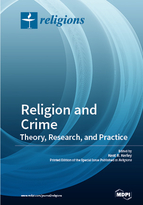Religion and Crime: Theory, Research, and Practice
A special issue of Religions (ISSN 2077-1444).
Deadline for manuscript submissions: closed (15 March 2018) | Viewed by 169210
Special Issue Editor
Interests: religion and crime; religion in prison; faith-based programs; religiosity; drug abuse; Evangelical Protestantism
Special Issues, Collections and Topics in MDPI journals
Special Issue Information
Dear Colleagues:
I am writing to invite your participation in a special issue of Religions, which is called Religion and Crime: Theory, Research, and Practice. As you may be aware, Religions (ISSN 2077-1444) is a relatively new international journal devoted to the scientific study of religion, and is published by MDPI. In just a few years the journal has achieved an impact factor over .50. Their website may be found at: https://www.mdpi.com/journal/religions/
Below is a summary of this special issue:
The scientific study of religion is a rather recent development in colleges and universities in the United States and in other nations. Beginning in the 1960s, researchers from many social science backgrounds began conducting data-driven studies of the extent to which religiosity is related to crime, deviance, and delinquency. Since the 1980s, social scientists have also studied the nature, extent, practice, and impact of faith and faith-based programs in prisons and other correctional contexts. This volume will contain the most contemporary and cutting-edge research on religion and crime, which includes data-driven (quantitative and qualitative), conceptual, review, and policy-oriented papers.
Studies of all major faith traditions and from all nations are encouraged. All manuscripts will be sent for peer review.
The manuscript submission deadline is March 15, 2018. Papers should be submitted via MDPI’s online submission site. You may go to https://www.mdpi.com/user/register/ to register and to complete the submission process. Because you have been invited to participate, the submission fee will be waived.
Please let me know if you are interested in participating or if you have any questions. If you would like to send me a brief description or abstract of a paper that you have in mind, that would be particularly helpful. I look forward to hearing from you and to receiving your submission.
Prof. Dr. Kent R. Kerley
Guest Editor
Manuscript Submission Information
Manuscripts should be submitted online at www.mdpi.com by registering and logging in to this website. Once you are registered, click here to go to the submission form. Manuscripts can be submitted until the deadline. All papers will be peer-reviewed. Accepted papers will be published continuously in the journal (as soon as accepted) and will be listed together on the special issue website. Research articles, review articles as well as short communications are invited. For planned papers, a title and short abstract (about 100 words) can be sent to the Editorial Office for announcement on this website.
Submitted manuscripts should not have been published previously, nor be under consideration for publication elsewhere (except conference proceedings papers). All manuscripts are thoroughly refereed through a double-blind peer-review process. A guide for authors and other relevant information for submission of manuscripts is available on the Instructions for Authors page. Religions is an international peer-reviewed open access monthly journal published by MDPI.
Please visit the Instructions for Authors page before submitting a manuscript. Submitted papers should be well formatted and use good English. Authors may use MDPI's English editing service prior to publication or during author revisions.
Keywords
- religion and crime
- religion in prison
- faith-based programs
- religion and crime control
- religion and drug abuse
- religiosity






